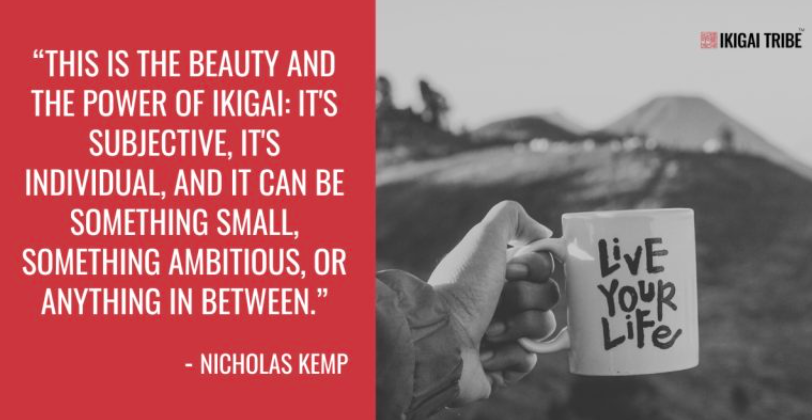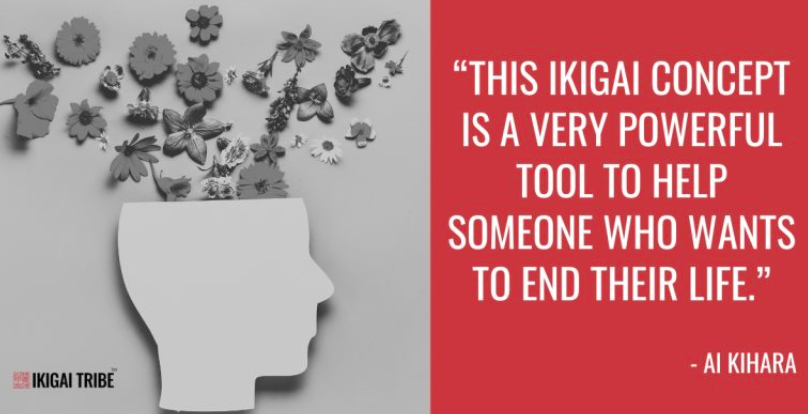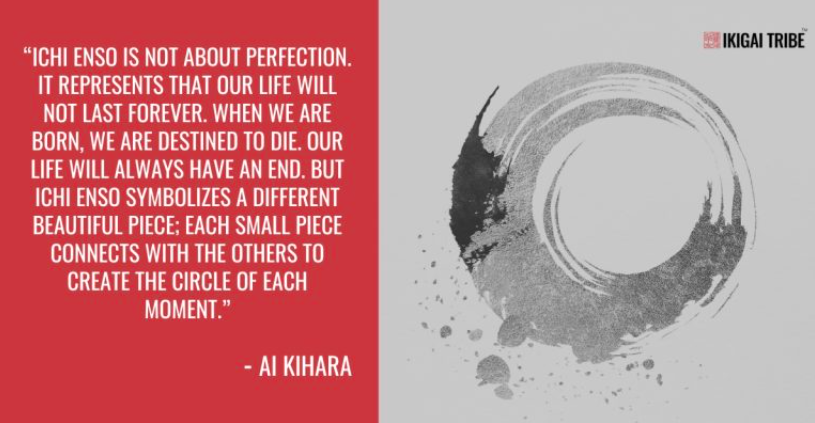Ikigai -Applying Japanese Wisdom in Counselling with Ai Kihara
Can Japanese philosophies help us navigate modern life challenges?
In this episode of the Ikigai Podcast, Nick speaks with Ai Kihara to explore how she brings Japanese concepts into her counselling practice, guiding individuals to cultivate resilience, discover meaning, and embrace a more mindful approach to life.
Podcast Highlights
Ikigai Tribe
Title: 113 – Applying Japanese Wisdom in Counselling with Ai Kihara
Podcast Blog Page Link: https://ikigaitribe.com/podcasts/podcast113/
Ai’s background. Ai shares a bit about herself.
Defining ikigai. Ai shares what ikigai is.
Incorporating ikigai into counselling. Ai discusses how she integrates Ikigai into her counselling practice.
Introducing Morita therapy. Ai discusses Morita Therapy and how she applies it in her counselling practice.
Akirameru. Ai introduces another concept that she applies.
Naikan therapy. Ai shares her own version of Naikan.
Ichinichi Ichizen. Ai explains the concept and its application.
Ichi Enso. Ai explains the meaning of Ichi Enso.
Ai’s ikigai. Ai shares her sources of ikigai.
Defining ikigai
“This is the beauty and the power of ikigai: it's subjective, it's individual, and it can be something small, something ambitious, or anything in between.” - Nicholas Kemp
Photo from Ikigai tribe
Ai shares that for Japanese people, ikigai is a simple yet deeply important concept, taught even to very young children. It can be something big, like her uncle’s purpose as a doctor helping people, or something small, like enjoying ice cream, sushi, or seeing a friend smile.
She noted that ikigai gained popularity in Japan after World War II, when people were poor and rebuilding their lives. It gave hope, helping people find meaning and motivation despite hardships.
Ikigai can come from different sources:
Connection with others: Since Japanese culture values collectivism, many people find Ikigai through relationships—like the strong bonds between mothers and children. Even those without formal jobs or wealth may find purpose in roles such as motherhood.
Work and contribution: Ikigai can also come from one’s occupation, regardless of status. For example, a supermarket checkout worker finds joy and meaning in helping others through his role.
Ultimately, ikigai is about finding meaning—whether through relationships, daily joys, or work—that helps people feel why they are here.
Incorporating ikigai into counselling
“This ikigai concept is a very powerful tool to help someone who wants to end their life.” - Ai Kihara
Photo from Ikigai tribe
Ai shares that she began using the concept of ikigai about 15 years ago while working at a national helpline and later as a supervisor. She found it to be a powerful tool for supporting people at risk of suicide when other frameworks or techniques felt insufficient. By asking callers about their ikigai—their reasons for living—many were surprised, sometimes even laughing as they realized they had many sources of meaning in life, big and small.
She applies ikigai in various situations, such as when people lose jobs, go through separations, face court cases, or re-enter society after jail. Unlike a fixed notion of purpose, ikigai is flexible, personal, and can change daily. In her trauma therapy work, she often asks clients questions like “Why are you here?” or “Why are you surviving?” which encourages them to reflect on connections, relationships, and small joys that give their lives meaning, helping them rediscover reasons to live.
Introducing Morita therapy
Dr. Shoma Morita (1874–1938) Japanese psychiatrist and founder of Morita therapy
Ai first learned about Morita therapy in 1994 while studying sociology at Osaka University. Developed by psychiatrist Dr. Shoma Morita, the therapy was created as an alternative to Western approaches to depression and anxiety, which emphasized constant activity, exercise, or medication. Morita observed that these methods did not fit well with Japanese cultural and holistic perspectives.
Instead, Morita therapy emphasizes rest and acceptance. Patients are encouraged to do nothing—rest, sleep, and avoid forcing feelings—until natural motivation to act arises. This approach forms the foundation for recovery because it allows individuals to process their experiences and regain energy authentically.
A key principle of Morita therapy is ‘arugamama,’ meaning acceptance of reality as it is, without self-blame or judgment. Though difficult, this acceptance—acknowledging conditions like depression or anxiety—gives individuals clarity about what they need to heal and move forward. Morita cautioned against distracting oneself with constant busyness, as true recovery requires reflection and acceptance of one’s reality.
Akirameru
Ai explains that akirameru is often translated as ‘to give up’ in English, but in Japanese Buddhism it carries a deeper, more positive meaning. The word akira means to clarify or see reality as it is, without emotional distortion. For example, instead of reacting with ‘my husband left me’ or ‘she was cheating,’ akirameru focuses on the factual reality: ‘he is no longer here’ or ‘she found someone else.’
The second step is to reflect on this clear understanding of reality, then ask, ‘What do I need? What do I want?’ and take appropriate action. In this way, akirameru is about acceptance and moving forward, much like the related concept of arugamama.
Naikan therapy
Ishin Yoshimoto sensei, Japanese Buddhist monk and founder of Naikan therapy
Ai shared that she created her own version of Naikan therapy while studying it as a university student, influenced by her spiritual upbringing. She has practiced it daily before bed since she was 18, viewing sleep as a kind of death and waking as a new life, in line with her belief in reincarnation.
Her adapted Naikan practice uses three simple reflection questions:
Did I do something for others today?
Did someone help me today?
What did I learn, and how can I feel appreciation for life?
Unlike the traditional form of Naikan, which involved monks severing ties with family and reflecting intensely on past relationships, Ai simplified the practice to make it more practical for everyday people. She also applies these questions with her clients to help them reflect, gain self-awareness, and cultivate gratitude.
Ichinichi Ichizen
Ichinichi ichizen means doing one good thing every day. Even children are encouraged to practice it, whether by helping with chores or simply smiling at a friend.
The idea originates from the six practices of Rokuharamitsu:
Fuse: Giving or donating, not only money but also small gestures, like offering chocolate.
Jikai: Keeping promises or commitments, supporting personal growth and responsibility.
Ninniku: Regulating emotions and avoiding overreaction.
Shojin: Working hard and giving one’s best effort.
Zenjou: Living in the present moment, rather than dwelling on the past or future.
Chie: Wisdom gained from integrating all the above
For Ai, living by these principles can inspire positive transformation, not only within oneself but also in the broader community.
Ichi Enso
Photo from Ikigai tribe
Ai explains that enso (a circle in Zen practice) carries different meanings for different people. Ichi Enso represents a ‘perfect circle,’ symbolizing satori, nirvana, and spiritual awareness. Yet, just like in mathematics, a truly perfect circle is impossible to create—reminding us that perfection lies in embracing imperfection and the interconnectedness of all things.
In 2018, during her master’s studies at the University of Auckland, Ai developed Zen Art Therapy, using enso as a central concept. She encourages clients to draw their own circles, whether imperfect, overlapping, or varied, as a way of expressing their personal meaning and awareness.
Ai shared an experience where she applied this concept while supporting a company through a traumatic incident. She realized she was just one small piece of a larger team effort, yet together they created a ‘perfect moment’ of professionalism, compassion, and love.
She adds that enso also reflects life’s impermanence: happiness, success, or relationships are never permanent, and life itself eventually ends. Still, each moment is a beautiful piece that connects with others to form the whole. Through drawing enso, clients are reminded of this balance of impermanence, connection, and meaning.
"Ichi Enso is not about perfection. It represents that our life will not last forever. When we are born, we are destined to die. Our life will always have an end. But ichi enso symbolizes a different beautiful piece; each small piece connects with the others to create the circle of each moment." - Ai Kihara
Ai’s ikigai
Outside of work, Ai’s greatest ikigai is her daughter, Hana. She chose the name Hana, meaning ‘flower,’ because she envisioned her as a small but powerful presence, like a tiny flower in the mountains that might give hope to someone in despair. Ai hoped her daughter could inspire others, even in subtle ways, to keep going in life. In honor of this, she named her company Hana Counseling, reflecting how deeply her daughter embodies her sense of purpose.
Conclusion
When understood and applied thoughtfully, Japanese concepts such as ikigai can offer powerful tools for those navigating life’s challenges. These philosophies provide guidance and inspiration, helping individuals uncover purpose, find meaning, and cultivate a deeper sense of fulfillment.








